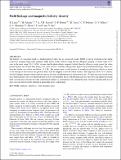Files in this item
Field linkage and magnetic helicity density
Item metadata
| dc.contributor.author | Lund, K | |
| dc.contributor.author | Jardine, M | |
| dc.contributor.author | Russell, A J B | |
| dc.contributor.author | Donati, J-F | |
| dc.contributor.author | Fares, R | |
| dc.contributor.author | Folsom, C P | |
| dc.contributor.author | Jeffers, S V | |
| dc.contributor.author | Marsden, S C | |
| dc.contributor.author | Morin, J | |
| dc.contributor.author | Petit, P | |
| dc.contributor.author | See, V | |
| dc.date.accessioned | 2021-06-07T14:30:15Z | |
| dc.date.available | 2021-06-07T14:30:15Z | |
| dc.date.issued | 2021-04-01 | |
| dc.identifier | 272951175 | |
| dc.identifier | f985e635-23f5-48fe-97ac-2a42dd8fce28 | |
| dc.identifier | 000637320100015 | |
| dc.identifier | 85105188336 | |
| dc.identifier.citation | Lund , K , Jardine , M , Russell , A J B , Donati , J-F , Fares , R , Folsom , C P , Jeffers , S V , Marsden , S C , Morin , J , Petit , P & See , V 2021 , ' Field linkage and magnetic helicity density ' , Monthly Notices of the Royal Astronomical Society , vol. 502 , no. 4 , pp. 4903–4910 . https://doi.org/10.1093/mnras/stab305 | en |
| dc.identifier.issn | 0035-8711 | |
| dc.identifier.other | Jisc: 823846cd2a3a42df99bfdaaf347358f3 | |
| dc.identifier.other | ORCID: /0000-0002-1466-5236/work/93894076 | |
| dc.identifier.other | ORCID: /0000-0001-5690-2351/work/139965417 | |
| dc.identifier.uri | https://hdl.handle.net/10023/23322 | |
| dc.description | Funding: MJ and KL acknowledge support from STFC consolidated grant number ST/R000824/1. VS acknowledges funding from the European Research Council (ERC) under the European Unions Horizon 2020 research and innovation programme (grant agreement no. 682393, AWESoMeStars). JFD acknowledges funding from the European Research Council (ERC) under the H2020 research and innovation programme (grant agreement 740651 NewWorlds). RF acknowledges funding from UAEU startup grant number G00003269. | en |
| dc.description.abstract | The helicity of a magnetic field is a fundamental property that is conserved in ideal MHD. It can be explored in the stellar context by mapping large-scale magnetic fields across stellar surfaces using Zeeman-Doppler imaging. A recent study of 51 stars in the mass range 0.1-1.34 M⊙ showed that the photospheric magnetic helicity density follows a single power law when plotted against the toroidal field energy, but splits into two branches when plotted against the poloidal field energy. These two branches divide stars above and below ∼ 0.5 M⊙. We present here a novel method of visualising the helicity density in terms of the linkage of the toroidal and poloidal fields that are mapped across the stellar surface. This approach allows us to classify the field linkages that provide the helicity density for stars of different masses and rotation rates. We find that stars on the lower-mass branch tend to have toroidal fields that are non-axisymmetric and so link through regions of positive and negative poloidal field. A lower-mass star may have the same helicity density as a higher-mass star, despite having a stronger poloidal field. Lower-mass stars are therefore less efficient at generating large-scale helicity. | |
| dc.format.extent | 8 | |
| dc.format.extent | 1268566 | |
| dc.language.iso | eng | |
| dc.relation.ispartof | Monthly Notices of the Royal Astronomical Society | en |
| dc.subject | Methods: analytical | en |
| dc.subject | Stars: magnetic field | en |
| dc.subject | QB Astronomy | en |
| dc.subject | DAS | en |
| dc.subject | MCC | en |
| dc.subject.lcc | QB | en |
| dc.title | Field linkage and magnetic helicity density | en |
| dc.type | Journal article | en |
| dc.contributor.sponsor | Science & Technology Facilities Council | en |
| dc.contributor.institution | University of St Andrews. University of St Andrews | en |
| dc.contributor.institution | University of St Andrews. School of Physics and Astronomy | en |
| dc.contributor.institution | University of St Andrews. Applied Mathematics | en |
| dc.identifier.doi | 10.1093/mnras/stab305 | |
| dc.description.status | Peer reviewed | en |
| dc.identifier.url | https://arxiv.org/abs/2102.11238 | en |
| dc.identifier.grantnumber | ST/R00824/1 | en |
This item appears in the following Collection(s)
Items in the St Andrews Research Repository are protected by copyright, with all rights reserved, unless otherwise indicated.

